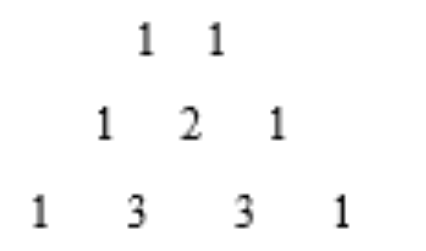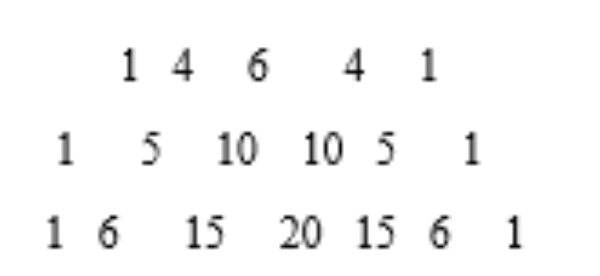
Assertion(A): In the expansion \[{(x + {x^{ - 2}})^n}\] the coefficient of eighth term and nineteenth term are equal, then n=25.
Reason (R): Middle term in the expansion of \[{(x + a)^n}\] has the greatest binomial coefficient.
1) Both A and R are individually true and R is the correct explanation of A.
2) Both A and R are individually true but R is not the correct explanation of A.
3) A is true but R is false.
4) A is false but R is true.
Answer
577.8k+ views
Hint: It’s very easy to calculate \[{(a + b)^2}\;or\;{(a + b)^3}\] but how can we calculate if the power is large?
For this purpose, we use Binomial Theorem,
Binomial theorem is a way of expanding any expression which is raised to a large power.
Now as per binomial theorem,
\[{\left( {x{\text{ }} + {\text{ }}y} \right)^n}\; = {\;^n}{\Sigma _{r = 0}}\;n{C_r}\;{x^{n{\text{ }}-{\text{ }}r\;}}\cdot{\text{ }}{y^r}\;\]
Where n can be any natural number and x and y can be real numbers.
Here the term apart from the variable is known as the coefficient.
General term in the above expression is given by,
\[{T_{r + 1}}\; = {\text{ }}n{C_r}\;{x^{n - r}}\;.{\text{ }}{y^r}\]
Also, \[n{C_r}\; = \dfrac{{n!}}{{r!(n - r)!}}\].
And \[n{C_r}\; = n{C_{n - r}}\].
Complete Answer:
Assertion:
Now it is given that the coefficient of eighth and the nineteenth term are equal, hence
Coefficient of \[{T_{7 + 1}}\;and{\text{ }}{T_{18 + 1}}\] are equal.
And as we know that \[{T_{r + 1}}\; = {\text{ }}n{C_r}\;{x^{n - r}}\;.{\text{ }}{y^r}\]
\[{T_{7 + 1}}\; = {\text{ }}n{C_7}\;{x^{n - 7}}\;.{\text{ }}{y^7}\]
And, \[{T_{18 + 1}} = {\text{ }}n{C_{18}}\;{x^{n - 18}}\;.{\text{ }}{y^{18}}\]
Hence, the coefficient of \[{T_{7 + 1}}\; = \] the coefficient of \[{T_{18 + 1}}\;\]
i.e. \[n{C_7} = {\text{ }}n{C_{18}}\]
As we know that \[n{C_r}\; = n{C_{n - r}}\]
Hence, \[n{C_{18}}\; = n{C_{n - 7}}\]
Equating the above equation, we get,
\[\begin{array}{*{20}{l}}
{n - 7{\text{ }} = {\text{ }}18} \\
{n{\text{ }} = {\text{ }}25}
\end{array}\]
Hence the assertion(A) is correct, i.e. in the expansion \[{(x + {x^{ - 2}})^n}\] the coefficient of eighth term and nineteenth term are equal, then n=25.
Reason:
Now We can see that, the coefficient of ‘x’ and ‘a’ are,

And if we will continue the expansion for larger power and follow the trend, the coefficient will be as follows,

This sequence is known as the Pascal’s triangle and each number is found by adding the two numbers directly above it.
Here in the end 20 comes by adding two 10’s above it.
Hence clearly we can see that the value of the middle term is largest.
Thus the Reason (R) is individually correct i.e. the middle term in the expansion of \[{(x + a)^n}\] has the greatest binomial coefficient. But (R) is not the correct explanation of the Assertion (A).
So, option (B) is the correct answer.
Note: The number of terms in \[\left( {n{\text{ }} + {\text{ }}r{\text{ }} - {\text{ }}1} \right){C_{r{\text{ }}-{\text{ }}1}}\]is n+1.
And the number of terms in the expansion of \[{({x_{1\;}} + {\text{ }}{x_{2\;}} + {\text{ }} \ldots {\text{ }}{x_r})^n}\;\;\]is \[\left( {n{\text{ }} + {\text{ }}r{\text{ }} - {\text{ }}1} \right){C_{r{\text{ }}-{\text{ }}1}}\].
For this purpose, we use Binomial Theorem,
Binomial theorem is a way of expanding any expression which is raised to a large power.
Now as per binomial theorem,
\[{\left( {x{\text{ }} + {\text{ }}y} \right)^n}\; = {\;^n}{\Sigma _{r = 0}}\;n{C_r}\;{x^{n{\text{ }}-{\text{ }}r\;}}\cdot{\text{ }}{y^r}\;\]
Where n can be any natural number and x and y can be real numbers.
Here the term apart from the variable is known as the coefficient.
General term in the above expression is given by,
\[{T_{r + 1}}\; = {\text{ }}n{C_r}\;{x^{n - r}}\;.{\text{ }}{y^r}\]
Also, \[n{C_r}\; = \dfrac{{n!}}{{r!(n - r)!}}\].
And \[n{C_r}\; = n{C_{n - r}}\].
Complete Answer:
Assertion:
Now it is given that the coefficient of eighth and the nineteenth term are equal, hence
Coefficient of \[{T_{7 + 1}}\;and{\text{ }}{T_{18 + 1}}\] are equal.
And as we know that \[{T_{r + 1}}\; = {\text{ }}n{C_r}\;{x^{n - r}}\;.{\text{ }}{y^r}\]
\[{T_{7 + 1}}\; = {\text{ }}n{C_7}\;{x^{n - 7}}\;.{\text{ }}{y^7}\]
And, \[{T_{18 + 1}} = {\text{ }}n{C_{18}}\;{x^{n - 18}}\;.{\text{ }}{y^{18}}\]
Hence, the coefficient of \[{T_{7 + 1}}\; = \] the coefficient of \[{T_{18 + 1}}\;\]
i.e. \[n{C_7} = {\text{ }}n{C_{18}}\]
As we know that \[n{C_r}\; = n{C_{n - r}}\]
Hence, \[n{C_{18}}\; = n{C_{n - 7}}\]
Equating the above equation, we get,
\[\begin{array}{*{20}{l}}
{n - 7{\text{ }} = {\text{ }}18} \\
{n{\text{ }} = {\text{ }}25}
\end{array}\]
Hence the assertion(A) is correct, i.e. in the expansion \[{(x + {x^{ - 2}})^n}\] the coefficient of eighth term and nineteenth term are equal, then n=25.
Reason:
Now We can see that, the coefficient of ‘x’ and ‘a’ are,

And if we will continue the expansion for larger power and follow the trend, the coefficient will be as follows,

This sequence is known as the Pascal’s triangle and each number is found by adding the two numbers directly above it.
Here in the end 20 comes by adding two 10’s above it.
Hence clearly we can see that the value of the middle term is largest.
Thus the Reason (R) is individually correct i.e. the middle term in the expansion of \[{(x + a)^n}\] has the greatest binomial coefficient. But (R) is not the correct explanation of the Assertion (A).
So, option (B) is the correct answer.
Note: The number of terms in \[\left( {n{\text{ }} + {\text{ }}r{\text{ }} - {\text{ }}1} \right){C_{r{\text{ }}-{\text{ }}1}}\]is n+1.
And the number of terms in the expansion of \[{({x_{1\;}} + {\text{ }}{x_{2\;}} + {\text{ }} \ldots {\text{ }}{x_r})^n}\;\;\]is \[\left( {n{\text{ }} + {\text{ }}r{\text{ }} - {\text{ }}1} \right){C_{r{\text{ }}-{\text{ }}1}}\].
Recently Updated Pages
Why are manures considered better than fertilizers class 11 biology CBSE

Find the coordinates of the midpoint of the line segment class 11 maths CBSE

Distinguish between static friction limiting friction class 11 physics CBSE

The Chairman of the constituent Assembly was A Jawaharlal class 11 social science CBSE

The first National Commission on Labour NCL submitted class 11 social science CBSE

Number of all subshell of n + l 7 is A 4 B 5 C 6 D class 11 chemistry CBSE

Trending doubts
What is meant by exothermic and endothermic reactions class 11 chemistry CBSE

10 examples of friction in our daily life

One Metric ton is equal to kg A 10000 B 1000 C 100 class 11 physics CBSE

1 Quintal is equal to a 110 kg b 10 kg c 100kg d 1000 class 11 physics CBSE

Difference Between Prokaryotic Cells and Eukaryotic Cells

What are Quantum numbers Explain the quantum number class 11 chemistry CBSE




